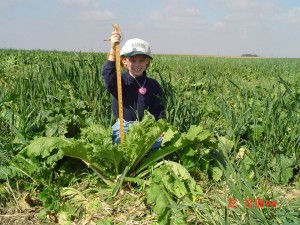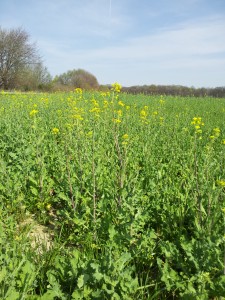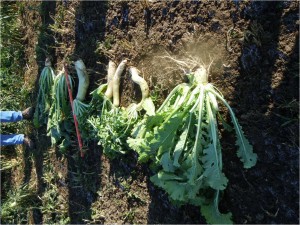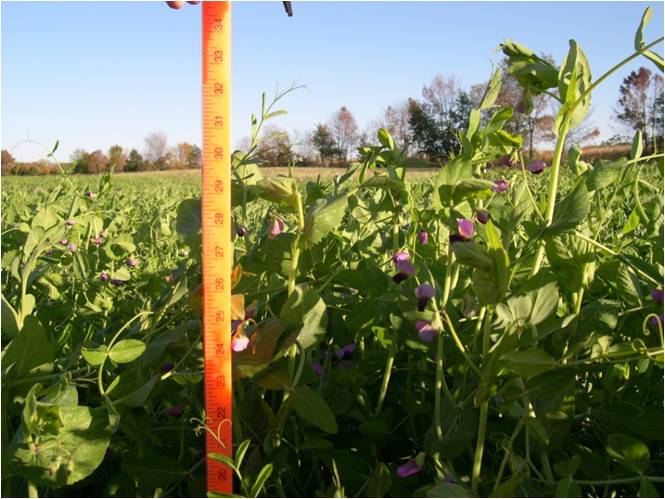Cover Crop Radishes or Turnips as a Cover Crop – or Both?
Cover crop radishes certainly receive a lot of press. I have researched them quite a bit over the past four years. On this blog alone I have over 20 posts about radishes. They are fun to take photos of, dig around in, research, and even play baseball with.
It is hard to pick up a publication that mentions cover crops and not read about radishes and their benefits. Some industry and university cover crop research leaders like Steve Groff and Dr. Ray Wiel (University of Maryland) have researched radishes for over 10 years.You might say that cover crop radishes are the “Rock Star” of cover crop species these days.
What About Turnips?

Why are turnips used as a cover crop so little compared to radishes? Are they the “ugly step-sister” of the Brassica family?
Let’s look at some of the benefits of turnips. Some newer varieties (Appin in particular) provide a bulb that is almost entirely in the soil and a deep root system (though a smaller bulb/tuber than the radish).
Benefits of Turnips
- Turnips are very palatable for grazing cattle and sheep.
- Most turnips survive the winter and hold onto nutrients into the spring (longer than radishes).
- Turnips sequester nutrients in a similar fashion and amount as radishes (see data below).
- Turnips are easy to kill in the spring.
- Turnips do not have the odor problems that radishes have (therefore they can be planted more “safely” in areas closer to towns or neighbors).
“Problems” with Turnips
- Not all turnips are created equal. The old purple top (or that type) turnip and even the tankard type turnips have very little of the bulb in the soil – thus less soil activity.
- Most turnips survive the winter and then need to be killed in the spring. Yes this can also be a benefit.
- The turnips “bolt” in the spring and want to produce seed. Kill them as early as possible.

Turnips will overwinter in the spring. The turnips above flowered out in March 2012 in central Indiana. This is nearly 5 weeks before “normal”
Frequently Asked Questions
- If we mix turnips and radishes together, is that okay? YES – for grazing or for just using as a cover crop.
- If we plant turnips instead of radishes is that okay? Yes – just be aware of the differences and that the turnips will most likely survive the winter.
- What if we are just looking to graze and only care some about the cover crop? Choose turnips.

Nitrogen tested in Radishes/acre from Loudonville, OH dairy farm averages 200 units of N (data collected November 2010)
Nitrogen tested in Appin Turnip/acre from Loudonville, OH dairy farm showed nearly 300 units of N (data collected November 2010)
The turnip tops had nearly 200 units of N/acre. This was NOT scientific but it is instructive that turnips are an excellent scavenger of N.


Never thought turnips were worth a look as a cover compared to radishes, but if Appin Turnips can pick up and hold more N and have a deep root system then they need to be checked out. Where can Appin Turnip seed be had? Also could they be planted later than radishes and still get the benefits since they don’t winter kill? Would be nice not to have to aerial seed to get enough grow time in a corn bean rotation. Thanks Dave.
Mark, One thing I have notices is that it takes longer for Appin turnip roots to develop than the radish roots…but they do eventually get deep and they are more cold tolerant than the radishes. I’d suggest that they don’t always take up more N than radishes but they take up a lot more than most people think! I’d still try to plant them as early as the radishes so they can develop a bigger bulb in the fall. I’d still aerial apply them if you could…but they will grow longer into winter than the radishes. Where are you from? I can make some suggestions on where to purchase the seed.
Watch grazing cattle on turnips. There is a definite choking hazard for calves and cattle. Sheep are OK.
Kevin, I have heard that over the years and you are correct that it could be an issue. However, in my 30 + years of selling forages I have actually only heard of it actually happening one time across the whole area that I have traveled (most of the USA). I believe that the tankard types and Forage grazing types (like Appin) are less of a risk. However, I know that it could happen, thanks for your comment! Dave
Dave,
I have heard that radishes can “fumigate” the soil ridding it of desease and pest eggs. Is this true and can Turnips do the same?
Holly
Holly, That can be true of both radishes and turnips. Mustard probably does better than either one of those! There is lots of great research being done at Michigan State University by Dr. Mathieu Ngouajio. Id suggest you do a web search on his work to see his excellent work on the brassia family and how they help in various ways. Dave
Dave,
What type of seed would you recommend for an urban garden?
Holly
Where are you from? What soil do you have? Sandy, clay (if wet your rubber boots get sticky and big), or silty (more slippery like soap). Either way, Tillage Radish is one of the things to put in. Most gardens are low in fiber (organic matter). We put our grass clippings on ours. Mixing some annual ryegrass with the radish works well. Adding a legume like hairy vetch adds some nitrogen. Seeding a winter cereal also is good for stimulating microbes in the soil. Let the winter cereal grow 8 – 10″ high, then mow it down, let it regrow. We also try to return most of the vegetable growth back to the soil. When our peas are done, we mow them. Radishes require 40 days of growth before a killing frost (3 nights of -9°C or 15°F). Best to work them into the ground in the fall. The biofumigant part of the radish may be too much for your neighbours.
Hey Kevin, I’m from NE Indiana and the farms in the blog post are silt loam to clay loam soil. Some of the radishes did not die this winter…and in my garden lots of radish seed sown last fall actually came up this spring! Like you I recommend and use a legume with radishes and ryegrass and/or rye.
Holly,
I like a number of cover crops for gardens. I prefer to mix a legume (Nitrogen producer) with a nitrogen scavenger. My “favorite” is a mixture of crimson clover (or peas)and radishes…or crimson clover and a grass like annual ryegrass or cereal rye. You can seed the cover crops as soon as the garden plants start to die out. So as the peas are finishing up you can plant either another garden plant…or add cover crops into that area. When the sweet corn is finished then add cover crops! That way the soil is always covered and feeding microbes and earthworms!
HAS ANYONE EVER USED TRITICALE FOR A FORAGE AND OR COVER CROP
Kody, Absolutely! Winter Triticale is not quite as winter hardy as Winter Rye and pretty similar to Wheat. It is a very good quality forage and a very good cover crop. It will be pretty similar to Wheat in maturity but quite a bit better quailty.
In response to Mark’s question, my results show clearly that you cannot plant turnips later than radishes. I have run that comparison with multiple planting dates for four years now at our Cornell research farm. They radish and turnip grow to a very similar extent in the fall. The difference is the cold hardiness after they have stopped growing. Both require at least 1500 GDD (32 base!) before a hard freeze to be useful. Planting to give 2000 GDD will double the biomass.
This work is done in Western NY, Zone 6a, right by I-90.
We use Appin and Pasja turnips, Biodrills (aka Groff’s) and GroundHog radishes. The turnips are sourced through Ernst in Pennsylvania.
How much N is lost with turnips and radishes when the tops are grazed? In other words, if I’m looking to graze the plants, should I consider N scavenging or not?
Matt, You will recycle N when you graze turnips and radishes. You can scavenge plenty then when the cows graze the high protein tops they will gain weight + recycle the N when they urinate and defaecate. Leave 3-4″ of growth on the tops when you graze so that the brassicas regrow and continue to scavenge. And also the oats or Rye or whatever grass you have with the brassicas will also scavenge N too. It’s a great agronomic and animal system! Dave
Hey Dave, I farm in north central Montana and I just harvested my barley crop. I’m thinking of spreading some turnip seed and irrigating it up for fall grazing and cover crop. I was wondering if there’s any possibility this can adversely affect my spring planting next season and if there are any precautions I need to take if I want to go back into the soil with a spring wheat or barley.
Thanks!
Joe,
I know of no ill effects that you would find from turnips going to Barley. Good luck!
Turnips sound interesting I may try some next year. Could I plant tunips after oats before I plant oats? Or could I plant turnips whit the wheat? . Where is best place to buy them ? I am in Central Michigan . Alma area. Thanks Darwin
Sorry screwed up we plant wheat after the oats….. How late can I plant them in the fall? Thanks Darwin
Darwin,
Planting Turnips in the fall should happen at least 6-7 weeks before a killing freeze (14-15 degrees F). If you would plant them with wheat it would be good to plant them in mid to late-September in central Michigan. If you plant turnips in the spring with oats would that be for spring grazing? If not, that would provide a real challenge for the oats to achieve maximum grain yield. Even at 1/2#/acre there would be too much competition as the turnips will create a considerable amount of shade. Dave
Dave, thanks for the advice earlier. I planted tillage radish with triticale and annual ryegrass for grazing. I had started to get a little disappointed with the radish because it grew much faster and I was worried it would be too much competition for the grasses that I want to graze this spring. I was also concerned that the cows were trampling too much radish tops into the ground instead of eating them. However, at the end of the grazing period I realized that they had done a good job eating what I thought they trampled. I also feel that I have a good stand of triticale and annual ryegrass for grazing this spring.
I do have a question, are there soil types that tillage radish may not work as well in? I have shale ground and when I deep till to bust up my hard pan I can hit spots of shale 6-10 inches down. I found the tillage radish popping out of the ground about 6 inches with only 6 inches going down. Would it be better not to use tillage radishes? Should I deep till before I plant tillage radish so I get better results?
Missing the new posts!
Thanks
I have been planting forage peas in the spring and baling them. I then plant sudex and bale that in the fall. My question is if I was to plant turnips and radishes at the same time as the sudex would they survive or be shaded out? I normally have been planting the sudex around the fourth of July. Northeast Nebraska
Lynn,
I have advocated planting a hybrid brassica with Hybrid Sudangrass for years. I have seen great success with 2-3#/acre of Pasja (or Vivant, T-Raptor, etc…) planted with 35+ #/ac Sudangrass and grazed. It will add moisture to the hay so maybe add 1-2#/acre instead. I have seen that work ensiled as well. I love the idea and wish more would use this combination.
Matt,
I never recommend using a deep ripper when you can use cover crops to do the job for you! Radishes typically do not like low pH soils so that may be a part of the issue you are seeing. The fact that the radishes are showing growth out above the soil surface generally is not so much an indicator of soil compaction but rather or good fertility when the radish grows rapidly and is growing down rapidly but also up as well. If you dig a root pit I will assume you will see deep roots from your radishes…the tuber may only be 6″ deep but the tap root may be as much as 30″ deep. That being said, I don’t know of any roots that will grow through rocks.
Hopefully more posts will be coming soon…on the road speaking all over North America this winter!
Dave
Im located in northern ky. I use cover crops on tobacco. How beneficial would using turnips and radishes be in my situation?
I have a lawn about 10000 Sq ft that is hard clay packed during construction 12 years ago. Can I use radish cover crop to break it up? Looking for any suggestions. Southwest Minnesota.
Ed, My wife will tell you “yes” as we tried radishes in our yard a couple of years ago! Just be aware that radishes don’t look like expensive lawn grass! Radishes will require nitrogen to grow well so add approximately 2-3# N/1,000 square foot to get some growth. FYI…I mowed my radishes 7-8 times during the year at ~4 inches high and they survived until a killing freeze. Perennial Ryegrass also does a great job and will be much prettier! If you try the radishes just be sure and tell the neighborhood that you are benefiting the health of your soil. 🙂
Tim,
Radishes and turnips could be very useful in your situation by scavenging significant N ad also breaking up the compaction created from the traffic and intense farming practices tobacco takes. I’d recommend a mix of 2-3# radish + 1# Turnips + 1 bu Cereal rye per acre will provide great benefit to you.
I live in south Georgia. How should I use turnips or other things for winter grazing for cows. Our lowest temperature in in the teens.
Ernest,
Yes, Turnips and a cereal grain (Oats, Rye, Spring Barley) and maybe annual ryegrass with them will be great. Make sure that the turnips are not over 35% of the diet.